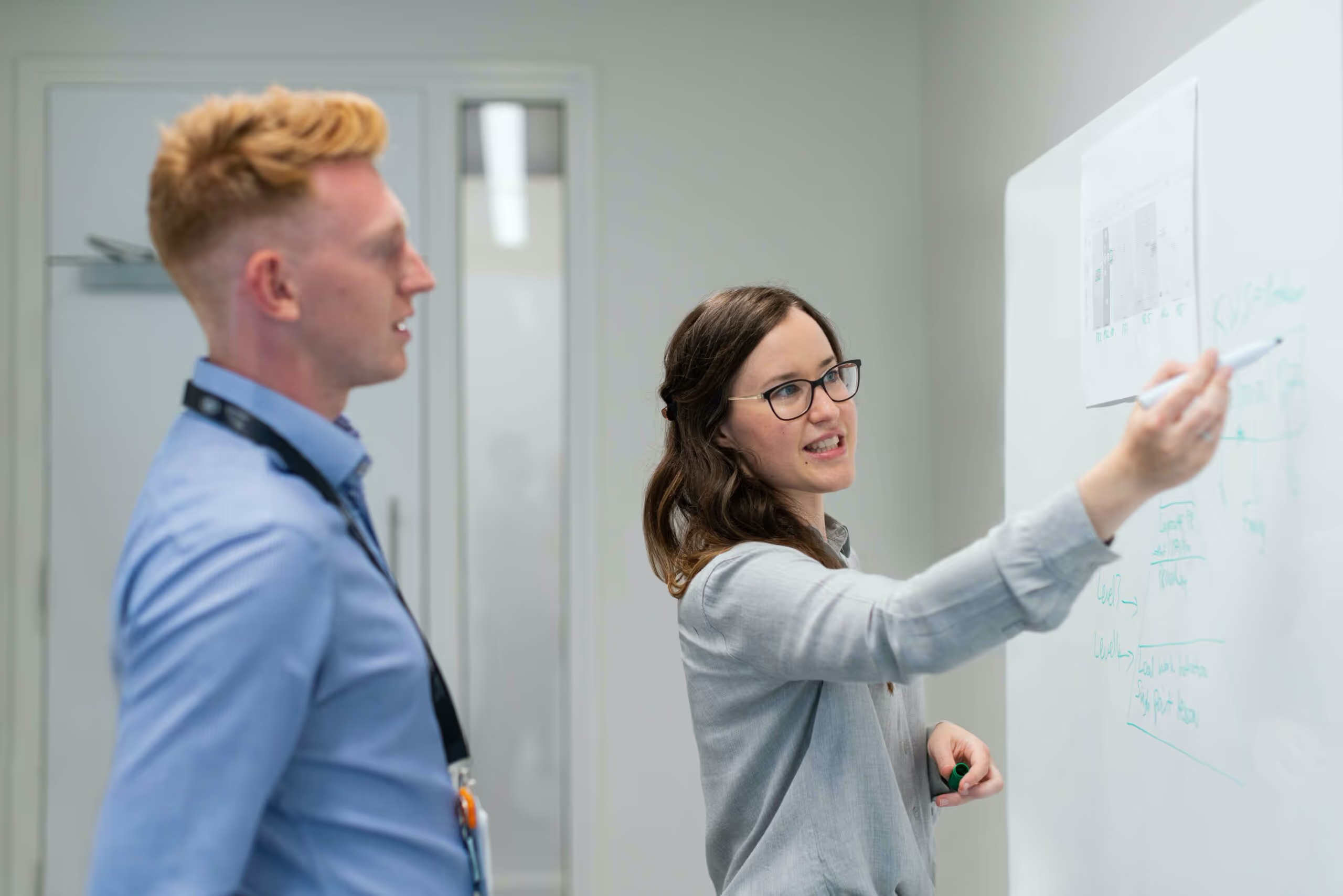Client Stories


Upskilling leadership in a virtual environment: Going beyond the cloud
A market leader in business software and solutions approached BTS with the desire to build better business acumen within its Human Resources leaders.
Adapting to innovate
Faced with a limited budget, the company asked BTS to repurpose an existing simulation for their program which had previously been delivered in a face-to-face format. BTS was tasked with adapting the simulation so that it could be delivered remotely.The goal of the program was for the company’s HR leaders to gain a better understanding of the organization — including their strategy, priorities, and customer needs — so that they could better serve the business and customers’ demands. The program was also designed to help establish the organization as an innovator, thought leader, and trusted partner for its clients who were undergoing digital transformations.
"We had to convert the existing simulation to the new audience and virtualize the feedback."
The process
Over the course of three days, participants experienced a faceted business simulation. The first day began with a group kickoff call and planning session. Teams broke up into smaller groups of five to become familiar with the virtual tool before competing in the first round of the simulation. The first day was built around key themes such as Vision, Strategy and Goal-Setting, as well as a Know–How (or learning session) on the company’s finances.The second day began with a debrief and feedback discussion on the previous day’s simulation round, where the results of the competition thus far were shared. Then, a Guest Speaker from the Finance department initiated the simulation’s second round by describing their Cloud transformation, or a transition to becoming the leading digital business platform. The third and final day began with a debrief of the second simulation round, along with a final application and closing reflection session.
The impact
The program, known as the “Learn the Business Experience,” accelerated the organization’s Cloud transformation. When comparing leaders’ NPS scores before and after the program, provided below, it was evident that participants deepened their understanding of the company’s business.
Business impact
A few months following the program, the organization collected the following data about participants’ responses. 89 percent of participants responded and granted the overall program an NPS score of 94 out of 100.
- 100 percent of participants agreed or strongly agreed that “the facilitators contributed positively to my learning experience,” and ranked the program an average score of 4.8 out of 5 in this category.
- 100 percent of participants agreed or strongly agreed that “the Business Simulation contributed positively to my learning experience,” and ranked the program an average score of 4.8 out of 5 in this category.
- 100 percent of participants agreed or strongly agreed that “the virtual workshop was an engaging experience,” and ranked the program an average score of 4.8 out of 5 in this category.
- 88 percent of participants agreed or strongly agreed that “I will be able to immediately apply what I learned on my job,” and ranked the program an average score of 4.3 out of 5 in this category.
- 100 percent of participants agreed or strongly agreed that “I have a better understanding of [the organization’s] business,” and ranked the program an average score of 4.8 out of 5 in this category.
- 94 percent of participants agreed or strongly agreed that “I have a better understanding of [our] customer needs and expectations,” and ranked the program an average score of 4.5 out of 5 in this category.
- 100 percent of participants agreed or strongly agreed that “I have a better understanding of [our organization’s] financials KPIs,” and ranked the program an average score of 4.6 out of 5 in this category.
- 94 percent of participants agreed or strongly agreed that “I feel comfortable to take part in discussions related to [our] business and strategy,” and ranked the program an average score of 4.2 out of 5 in this category.

Top-line growth and quality patient care
An integrated healthcare organization committed to providing affordable, high quality healthcare services wanted to develop a new, enterprise-wide leadership development program for its mid-level leaders, reaching every department. The company needed a program focused on enabling an “enterprise thinking” mindset that would give leaders a broader perspective on their business. Such a paradigm would allow leaders to better understand key trade-offs between improving operational efficiency and increasing quality of patient care, demonstrate resilience among shifting industry regulations and trends, and meet the various ongoing challenges faced by healthcare organizations, all while balancing “mission vs. margin” objectives.To achieve broader enterprise thinking, the healthcare organization partnered with BTS to design a customized business simulation modeled after its existing business. This solution sought to provide participants with a deeper understanding of how their departments’ operational decisions affected “the big picture,” and also to help them identify the areas in which these decisions most significantly impacted bottom-line improvements, strategic alignment, and decision making. In the simulation, each leader:
- Practiced making trade-off decisions on key investments and discovered how each decision was inter-related.
- Gained insight into how others perceived them as a leader by increasing self-awareness of their own behaviors while running the business.
- Learned best practices for cross-functional, high-performing teams to manage stress and build resilience.
The simulation created a risk-free, engaging, and fun way to achieve these learning objectives. Participants gained a holistic view of the organization’s value chain, which ran from attracting new health plan members to decreasing the average length of a hospital stay and system-wide medical costs.The simulation’s unique approach to learning placed participants in challenging, realistic scenarios. By reasoning through the simulation, participants drew from both their own experiences and their peers’ to adopt new behaviors, enabling them to manage their business areas more successfully. After each year of the simulation, BTS consultants presented feedback on and analysis of each participant’s results to demonstrate outcomes of the various strategies at play.Faced with relevant and high-impact business challenges, participating teams strove to maximize operating margins, revenue, quality of care, community wellbeing, service experience (including member satisfaction), and employee performance. Participants also assumed the position of someone on the executive team, formulating a strategy and prioritizing investments on a quest to generate the most improvement on the overall financial health of the organization.
An Experiential Learning Program
The simulation was composed of three rounds experienced over four days. Each round had a distinct theme and set of learning objectives.The first round focused on understanding the enterprise from top to bottom:
- Growing the top line by managing membership through a mixture of affordability, service experience, and access.
- Sustaining financial performance and improving quality of care through controlled usage across care settings.
- Attracting and retaining talent through opportunity for growth, education, wellness, and safety.
The second round focused on managing the system, from member to employee:
- Capturing growth by responding to an evolving market and new partnerships.
- Leveraging enterprise resources and excellence to drive local outcomes.
- Investing in the workforce to drive member retention through employee engagement and consumer experience.
The third round involved creating momentum for a sustainable business:
- Promoting whole health, which describes social determinants of health such as mental health and financial stability, and community wellbeing, thereby improving system affordability.
- Investing to meet the patient needs of the future, while still managing total cost of care.
- Building resilience by maintaining focus and influence across the individual’s network.
Learning by doing
Before the four-day program began, participants were asked to read a detailed case study describing a fictitious company in a fictitious market environment, both modeled after the real healthcare organization and its environment.On the first day of the program, leaders were divided into five teams. Each team entered a strategic planning session during which they set their business decision-making strategy and planned how to preserve resilience across the three simulated years. Within each team, leaders received one of six roles: Head of Health Plan, Head of Hospital, Head of Outpatient Clinic, Head of Outpatient Pharmacy, Head of Shared Services, and CEO / Head of Community Wellness.In the simulation, leaders made critical decisions across three areas. The first is Member Segments, which includes Groups, Individuals, and Medicare. Medicaid is also one of the member segments, but leaders don’t make direct decisions for this member group. The second is Points of Care, which includes the Health Plan, Hospital, Outpatient Clinics, and Pharmacy. The third is Shared Services, which involves enterprise decisions around core infrastructure, data analytics, mobile experience, and community involvement.Over the three simulated years, the marketplace evolved, forcing teams to react to the needs of every member segment. For example, when the business expanded into a new geographic region, teams had to decide which products to bring to market. In another, Medicare growth and demand far exceeded expectations, and leaders had to recalibrate priorities. Periodically, teams would receive a “Wobbler,” or an unexpected event requiring that they respond in real-time. Examples include a sudden drop in patient satisfaction scores, drug shortages at pharmacies, or a staph infection within the hospital. Teams' decisions impacted both KPIs and their market share for each market and segment.
Playing to win
Team performance was measured by four primary metrics: operating income, revenue growth, quality of care, and community wellbeing. Leaders’ choices were also benchmarked according to additional metrics that reflect relationships across the enterprise, including member satisfaction, service experience, employee engagement, and access.Leaders also participated in “debrief” sessions to discuss the results of running the simulated business, which were integrated with observations of each individuals’ resilience, agility, and stress regulation throughout the round, particularly when facing critical moments.While running their simulated companies, leaders experienced two “Know-How” sessions, which are mini-learning sessions to deepen their knowledge of the business and learning objectives. The first session focused on driving affordable care by deepening comprehension of income statements and building patient health-management skills, while the second featured a patient journey map that highlighted the critical moments in a patient’s healthcare journey.After experiencing all three simulated rounds, leaders entered an “Application” session, identifying the actions and behavior shifts that would drive business results back on the job. They also created “Go-Dos,” which are goals designed to sustain lessons learned and yield meaningful change. Following the program, every participant received follow-up emails reminding them of their Go-Dos, each embedded with a secure link that allowed leaders to update and track their progress.
Participants’ Key Session Takeaways
- “Every decision has a takeaway. While trying to solve any problem, the decisionmaker needs to consider all factors.”
- “[I grasped] the complexity of our system and how to manage it by engaging with colleagues more broadly.”
- “[The importance of strategic thinking, whole system consideration, and the necessity of strategic collaboration between outpatient and inpatient teams to improve affordability.”
- “The business simulation was excellent. It demonstrated the business’s complexity and interconnectivity and also required great discourse within groups.”
- “[I appreciated] the real-life aspect of having to make decisions quickly and resolve competing priorities. We may have the best intentions, but we need to ensure that the organization is sustainable and taking calculated risks. The simulation showed that clearly.”
Post-Program Participant Actions
As a result of the experience, participants had a better understanding of the organization’s strategy and business; specifically, about increasing operational efficiency. Each participant committed to concrete actions they would take back on the job to make an impact on the organization. A total of 135 Actions were submitted to and tracked by BTS. As of 6 months post-pilot, 30.02% of actions were completed, and 36.71% were in progress.Highlighted below are specific outcomes resulting from participant on-the-job actions:
- “I had my team collaborate on how to save money… while maintaining our mission of integrity. In doing so, our team has created and implemented new cost-saving initiatives for the entire service area around waste and hazardous expiring supplies.”
- “I met with my finance team to see how I can help with my department’s budget. As a result, we were able to get payroll back on track and strategize hiring new staff within the payroll budget.”
- “I shared my learnings from this Business Simulation with my Direct Reports, especially [about] the balancing act needed between growth, market share, maintaining quality, service experience, member/patient satisfaction, [and] revenue, as well as a focus on innovation. Through sharing my learnings consistently… I have seen more buy-in and more receptiveness in implementing changes and making process improvements related to the initiatives. This has impacted our department’s efficiency and encouraged innovative solutions to our current issues.”
- “After participating in this experience, I have strong support for virtualization initiatives. My team is now supporting virtualization efforts in our service area through implementing Bluetooth-enabled devices in our Advanced Medical Care at Home or Hospital at Home program, which impacts our financials, but also member satisfaction and retention.”

Delivering great care while driving the business
Leadership development at a leading provider of home health and hospice care
A leading provider of home health and hospice care in the United States consistently delivers high quality care but strives to be the premiere solution for patients across the country to age in place.
To meet this ambitious goal, the organization identified the need to develop their people, providing them with the leadership and business skills necessary to drive results and continue providing top-of-the-line care.
At the company, often the best physical therapists, nurses, and occupational therapists are selected to lead care centers, shifting roles from a caregiver to a business leader. Care center leaders report to regional heads and are responsible for managing their care centers’ P&L, holding other caregivers accountable, and growing the business. These major responsibilities can be challenging for many new care center leaders. While they have excelled as caregivers, their background is not in business.
Embarking on a transformative leadership journey
To mediate this issue, the organization engaged with BTS to help care center leaders gain the skills required for their role and familiarize themselves with the tools that will enable their success. Through a series of intensive interviews, BTS created a customized program to fit the healthcare company’s specific needs.
The program is a two-day offsite, during which participants embark on an experiential learning journey to practice their business acumen and leadership skills. In addition to the 25 care center leaders in attendance, there are also a handful of regional heads who participate, making a total of 30 participants, with several senior observers overseeing the program. The goal of the program is to reach all care center leaders within the organization, equipping them with the skills and tools to successfully lead and grow the business.
Being a Multiplier, developing business acumen, and honing leadership skills
Before the program kicks off, participants are asked to read a short article on Liz Wiseman’s Multipliers, which prepares them for their leadership learning journey.
On the first day of the program, leaders immediately jump into a customized business simulation, running a care center in a simulated environment. Both new and tenured leaders test the behaviors and skills required for the job in a risk-free environment where their mistakes will not affect the business. In this first round of the simulation, leaders focus on optimizing their caregiver mix and utilization levels, ensuring resources are adequately meeting patient needs and providing the best care profitably. This round takes half of a day, but simulates an entire quarter of running a care center. Participants will later receive feedback on their performance in the simulation, learning how their decisions impacted their simulated business. All of the results are contextualized in the company’s service-value chain so that participants can understand how both their business and leadership choices make a measurable difference.
In the afternoon, leaders are exposed to the BTS Multipliers Framework, based on the concepts from Liz Wiseman’s Multipliers, which describes how leaders can encourage those around them to reach their full potential by tapping into their teams’ natural talents and “multiplying” their impact. Leaders are also exposed to “accidental diminishers,” which describe well-intentioned behaviors that accidentally inhibit people’s ability to make mistakes and subsequently learn and grow. Participants engage with these concepts through a moments-based playbook, learning What Great Looks Like and What Not So Great Looks Like in the most pivotal moments they encounter in their role.In the afternoon, leaders are exposed to the BTS Multipliers Framework, based on the concepts from Liz Wiseman’s Multipliers, which describes how leaders can encourage those around them to reach their full potential by tapping into their teams’ natural talents and “multiplying” their impact. Leaders are also exposed to “accidental diminishers,” which describe well-intentioned behaviors that accidentally inhibit people’s ability to make mistakes and subsequently learn and grow. Participants engage with these concepts through a moments-based playbook, learning What Great Looks Like and What Not So Great Looks Like in the most pivotal moments they encounter in their role.
For the remainder of the day and in the following morning, leaders are divided into two cohorts, one of care center leaders and the other of regional heads, to respectively practice giving feedback and coaching skills. The division of these two cohorts allows for more candid conversations and targeted learning opportunities as they discuss existing challenges they face in their role and potential ways forward.For the remainder of the day and in the following morning, leaders are divided into two cohorts, one of care center leaders and the other of regional heads, to respectively practice giving feedback and coaching skills. The division of these two cohorts allows for more candid conversations and targeted learning opportunities as they discuss existing challenges they face in their role and potential ways forward.
In the second round of the simulation, participants have the opportunity to run their care center again, and this time are better equipped for success. The results of this round allow participants to see how applying their learnings can enhance business performance, and what mistakes to avoid when applying their skills to their care center in the real world.
At the close of the two-day program, the company’s Chief Operating Officer and President present the company’s future outlook, inspiring participants to apply their learnings in support of the company’s ambitious growth goals.
The learning does not stop after participants leave. After the program, cohorts continue to peer-coach in three subsequent, virtual coaching sessions. These coaching sessions sustain the learning by addressing obstacles faced in the field, providing a platform for success stories, and giving further opportunities to practice in a safe space.
Sustained momentum: impressive results
Since the program’s inception, net income from operations (NIFO) has improved by roughly $10M, fostering a business-focused, feedback and coaching culture through improved alignment. Based on post-program interviews, the organization estimates that at least 30% of the $10M in additional NIFO was due to the training initiative.
In addition, the program received world-class results with an average NPS of 9.2. Over 350 care center leaders and regional heads have been through the program, with more than half (63%) reporting knowledge transfer and nearly all (97%) participants reporting behavior change.
The healthcare provider is still on its leadership journey, but the results so far prove the program provides significant impact on the skill level and tool application for leaders, giving them the capabilities they need to successfully run the business while continuing to provide the care that their patients deserve.
NPS comments cite the program as a “game changer” and “eye-opening.”
“I would definitely recommend this experience to my colleagues. Information shared on giving feedback both positive and negative will be a game changer for this organization.”
“I learned more about my leadership abilities and ways to improve it or correct it than any other meeting I have attended.”
“This conference brought to light more of what I have been doing ‘wrong’ but certainly opened my eyes to what I can do better to assist my care center in future growth. Thank you.”

Leadership development to drive great strategy execution
A Path to Growth
With the induction of a new leadership team, an American department store unveiled a novel strategy that offered an exciting vision for the future. The new strategy would align the organization’s strategic priorities to their values, ultimately resulting in a more unified business and customer experience. Although the strategy was in place, it would take the right culture to drive sustained growth.
Defining great at all levels
The organization first revisited the values and behaviors that defined their culture. In partnership with BTS, they took a contemporary approach rather than using standard competency models and made the values relevant to all colleagues, not just executives or select groups. To do this, BTS conducted over 120 interviews with leaders across every level and function in the organization, defining “Our Behaviors” in support of the new strategy, identifying what Great looks like at every level across the organization.
With the behaviors in place, it was critical for the organization to communicate them to all leaders and allow them to experience the behaviors in an engaging and impactful way.
Leadership development for cultivating change
In partnership with BTS, the organization created a series of customized, moment-based leadership simulations that introduced leaders to the new behaviors and allowed them to practice these behaviors as if they were acting on them in real life.
The experience would roll out in three waves, first addressing the top 1,200 leaders of the organization, next going to all 20,000 salaried colleagues, and finally to all 110,000 hourly colleagues. This approach ensured that every level of leadership would understand the new behaviors and skills necessary for success, gaining ownership of the new strategy.
Living the behaviors
The first iteration of the leadership development program was an offsite targeting 1,200 leaders of functions and leaders of leaders. On the first day of the program, leaders were introduced to the new values and behaviors by their CEO and CHRO. They also experienced a digitally enabled moments-based simulation where they engaged with activities that allowed them to learn and understand the new leadership behaviors they would need live in order to drive growth.
The 1,200 leaders were broken into eight groups of 150 leaders, with one BTS consultant and two senior executives to facilitate each group. The simulation allowed participants to feel as if they were applying their learnings back on the job, because the simulated moments they experienced were directly modeled after scenarios that leaders would face in real life – but in a risk-free environment tailored to enhance learning. Ultimately, the goal of the first day was to help leaders practice, discuss and debate the new behaviors, understanding why they needed to change their values and leadership behaviors in support of the new strategy and path to growth.
On the second day of the program, leaders crafted and practiced elevator pitches communicating these new behaviors and key messages with their teams. They also identified individual commitments to living the new behaviors in support of the strategy. Commitments were entered into Act@BTS, an automated BTS tool that provides just-in-time reminders and notifications, and themes were identified and shared back by the CEO at the conclusion of the offsite.
Ultimately the goal of the program was to have participants walk away hyper-aligned to the new culture, how to operate using the proper behaviors, and feeling committed to the role each leader and their team plays in driving the culture and strategy.
Cascading the change throughout the organization
This methodology was taken and applied in a secondary 90-minute program for all 20,000 salaried colleagues. Leaders would experience a similar moments-based simulation as the previous cohort, but with moments that were tailored more closely to the demands of their specific leadership level. Due to the scope of this delivery, salaried colleagues experienced the program in either live face-to-face or virtual settings. The goals for the second cohort remained the same – leaders needed to live the organization’s behaviors and use their learnings to drive strategic change for the business.
Following the first two iterations of leadership development among the top leaders and all salaried colleagues, the leaders experienced modules that allowed them to integrate their learning into their team rallies, team meetings or on the floor in one-on-one conversations for all 110,000 hourly colleagues. The salaried colleagues used a guidebook that provided content and scripts for them to follow based on their setting and the time they had. Again, the experience was tailored more closely to the demands of hourly colleagues. This enabled every leader within the organization to drive the essential learnings from the top to the bottom of the organization.
Results
The results of the culture shift are still being measured, but the program has created some impressive results. The sessions have scored an average of 97 NPS. Nearly 4,000 commitments have been submitted to the BTS ACT platform. In the most recent Culture survey, which is tied directly to the new behaviors, the organization showed an increase across all measurable areas.
Examples of act commitments include:
“I will engage my colleagues to create a roadmap that guides our individual and collective behaviors and actions. This will support our organizational growth initiatives by continuously identifying ways to improve and acting on them by an established deadline.”
“I will lead my store team with passion and energy toward a mindset of approaching getting better every day relative to personal and store growth. I will strive to keep our team energized and focused on providing a motivating and engaged environment that delivers an amazing customer experience and drive comp sales growth this year by an established deadline.”
“I will commit to sharing and discussing results daily with my team which will foster a greater understanding of our wins and opportunities in the building and keep the leadership team focused on growth by an established deadline.”
Qualitative results from participants include:
“I have managers present their business results at our weekly leadership meeting. I also have them share their best and their worst. As a result, they are displaying more confidence in understanding the business and being more proactive in working with others to make fixes.”
“We reviewed our behaviors and identified what can be accomplished in a consistent manner. This cannot be a one and done exercise if we are going to establish the culture and change behaviors. We now have bi-weekly meetings to discuss and review everyone’s accountability.”
“I am now coaching to align with committing to win, through customer engagement and experiences.”
Quantitative results from participants include:
- Delivered 101 percent to sales plan for Q1, and 104 percent to sales plan for Q2, with every metric improving
- Achieved +2.7 percent over plan for Q1 results
- At 102.9 percent to plan on the quarter
- Getting 19 percent more inbound productivity, $350K better than plan
- 4 percent improvement in processing time in year to date
- Double digit improvement from previous month in time to market
Program Feedback:
“The breakout sessions were fantastic. Everyone at every level can always practice and develop leadership skills. Loved interacting and practicing with colleagues to better ourselves to take the best version of ourselves to our teams.”
“Breakout sessions with time to practice our implementation.”
“Would like the exercises we did in the first days’ breakout session regarding our behaviors and the scenarios sent to us. Great exercise to do with our teams.”
“The content was amazing. I also enjoyed how the 2 days were broken out with the breakout sessions. It was a great way to collaborate and discuss with our colleagues from around the country.”
In addition to this highly positive feedback from participants, the program also received external recognition for its effectiveness. The Path to Growth program was awarded the coveted Gold Brandon Hall Group award for Excellence in Leadership.
In conclusion
The organization is only beginning to see the impact of their investment in building their culture in support of their new strategy. Despite this, the results are still impressive. Investing in leadership has created a positive impact, demonstrated through both qualitative and quantitative feedback, showing how leaders are living the values and culture that will enable their path to growth.

New Leader Program: Embarking on a leadership journey
Client need
A multinational software corporation needed a powerful solution to develop its first-time leaders, who were rapidly being promoted to new roles but lacked an understanding of how to lead at the company. Recognizing the need to develop this talent, the company partnered with BTS to co-create a 14-week learning journey.
The solution
- Focused on cultivating the three critical skills identified as necessary for first-time leaders in the organization:
- Giving feedback and coaching
- Achieving results through your team
- Leading high-performance teams
- Included three “Practice with an Expert” sessions. In each, participants were paired with a BTS Assessment Expert who helped them practice new skills, give feedback and coach them on how to apply their new skills back on the job.
Results
- 93% of program participants strongly agreed that, "The overall learning experience was valuable."
- 95% of program participants strongly agreed with the statement, "I believe the skills developed in the program will help me be more effective as a leader at the company."

Putting yourself in your client’s shoes
Client need
A big four consulting firm–a global leader in assurance, tax, strategy and transaction, and consulting services—needed to enhance their account managers’ abilities to understand the day-to-day challenges of their clients, which spanned an impressive and diverse portfolio of industries.
BTS has been a key thought partner to the firm for several years, delivering hundreds of experiences for leaders throughout the organization. In 2020, BTS partnered with the firm to deliver a virtualized New Senior Manager and Associate Director Program, adapting a program that had formerly been face-to-face to the new virtual environment.
Solution
To develop client empathy among the firms’ account managers, BTS created a suite of customized business simulations that represented the varying organizations within the firms’ client base. Working together in teams, account managers would go through the simulation and experience what it’s like to run these companies in a competitive marketplace.
BTS designed and delivered these entirely virtualized simulations for all new Senior Managers and Associate Directors in the company. These leaders experienced an immersive virtual journey that allowed them to: join at a convenient time, regardless of their global location; access an abundance of engaging virtual materials; and seamlessly engage with technology through the support of virtual operators.
In each simulation, leaders experienced events that highlighted the typical issues sector companies currently face. They also experienced oncoming shifts within industries, which included: changes in regulations; macroeconomic shifts; the impact of globalization; competitor consolidation; new entrants; and changes in product lines among many other disruptive factors. The teams’ decision-making has an impact on performance and market results in real-time.
After each round of the simulation, leaders are asked to use their cross-functional point of view to identify specific areas of opportunity for the simulated client. Each team then presents their suggested service offerings to a Partner at the organization, and continue to practice leading a client conversation around a topic from the simulation so that after the program they can have this conversation with one of their clients.
At the end of each simulation round, BTS facilitates a debrief session. These debriefs provide an opportunity for learners to understand how their team’s decisions impacted the results, which team performed the best, and which industry trends made the biggest difference.
Measurable impact
BTS’s industry simulations have delivered great success at the firm, both in person and virtually…
- 100% of participants felt the BTS simulation was a valuable learning experience and a worthwhile investment
- Within 3 months, over 85% of participants applied their learning, resulting in either immediate additional revenue, cross-service line opportunities, or increased client satisfaction
- Within 6 months, the average number of business opportunities for those who attended versus those who did not have increased, and the average value per opportunity had increased by $460,000 per participant
Virtual program testimonials:
- “Across the three areas we delivered training virtually in what has been an unprecedented year and despite these challenges, I feel our senior managers and associate directors still achieved both the celebration and recognition of their promotion and more importantly the insights and participation of our world class milestone program.”
- “Team activities in the simulation were very useful to put you in the shoes of our clients and think about their competing priorities and understand their decision making."
- “The most engaging virtual training I’ve seen!”
- “The simulation was the highlight. We got to build better relationships with our team, as well as apply what we learned from online training and reading, to our new leadership roles in helping build value for the company. This includes how we balance investments, opportunities, people, quality, reputation and clients.”
- “BTS was great at covering so much content in a short space of time and knew how to handle the conversations about real-life stories and examples.”
As an advisor to clients across many industries, BTS partners with the firm to provide industry-specific business acumen simulations in the following sectors:
- Advanced Manufacturing
- Consumer Goods
- Construction
- Energy & Resources
- Financial Services
- Government & Public Services
- Health Sciences and Wellness
- Hospitality
- Media
- Mobility
- Professional Services
- Real Estate
- Technology
- Telecommunications

Calculated risks towards growth
Client need
Due to the Covid-19 pandemic, a retail company had no choice but to lay off 80% of their employees in the first half of 2020. To help reengage their employee population and help the business recover post-crisis, the company partnered with BTS to co-create a virtual offsite.In the past, the retail company partnered with BTS to run in-person strategy simulations for their store managers. Given the notable success of past programs and seeing the value from the mindset shifts and behavior change of participants, the organization chose to partner with BTS again – this time for a much larger audience.The goal of the company’s offsite was to democratize commercial acumen in the organization’s store population and help develop a culture in which employees feel empowered to take calculated risks in pursuit of growth and improved customer experience.
The solution...
BTS partnered with the organization to design a half-day customized hybrid simulation experience delivered virtually, with some participants joining individually and others co-located in stores across the country.
The experience
- Tailored to the context and culture of the business – as a sporting goods retail company, the simulation was designed as a metaphor for a sports event in which participants competed throughmultiple “quarters” of a game.
- Leveraged self-paced modules and virtual tools – each “quarter” had different activities ranging from learning reflections to ‘what-if’ scenarios and decision-making tools.
- Involved real-life scenarios leaders face on-the-job – participants practiced both soft skills such as handling behavioral and leadership challenges, and hard skills such as calculating Return on Investment (ROI).
- Seamlessly integrated with the organization’s new communication platform, Microsoft Teams.
- Reached 2,500 employees in target regions across the country – including co-located teams and individuals joining virtually.
To ensure long-term learning and on-the-job integration, BTS created a ‘deep practice’ decision-making tool, based on key store metrics. The tool enables results to be seen in real-time, allowing participants andsenior management to identify opportunities for improvement across regions. Leaders can use the tool directly from their mobile devices back in the store to continue practicing decision-making and running ‘what-if’ scenarios throughout the year.
How it works
- Leaders enter assumptions on store key performance indicators into the tool.
- Then they can enter a set of investment assumptions and compare multiple scenarios.
- The tool will calculate the ROI on the ‘calculated risk’ based on the assumptions entered, enabling users to build confidence in their decisions by using data.
Outcomes of the event
- The organization loved BTS’s ability to deliver multi-modality learning that created a very educational environment and reached the entire store population.
- The company also believed in BTS’s ability to model the business’s ‘calculated risks’ concept that was integral to their store strategy.

Increasing agility for a healthcare organization's HR department
Client need
The world’s leading children’s hospital sought to improve its HR department’s ability to develop and retain top medical talent. To counter frustrations caused by the hospital’s recent exponential growth, HR recognized the need for a clear service strategy, as well as greater flexibility in the interpretation of policy. With these challenges in mind, the hospital came to partner with Netmind, a BTS Company, to increase collaborative team building, enhance the customer experience, increase role transparency and efficiency, and create a common set of tools and processes for holistic problem solving.
The solution...
Netmind designed a workshop-driven solution for all 11 business areas within HR, centered around agile sprints that enabled bite-sized learning and addressed the following four objectives:
- Collaborative Team Building: gamification, agile planning, milestone celebrations, goal-setting, and use of tools such as shared drives
- Enhanced Customer Experience: familiarity with customer personas and types, perspective-building workshops, customer journey mapping, and customer-experience toolkits
- Core Process Mapping and Visualization: combat siloes, visualization techniques, mapping value streams, and identifying core capabilities
- Continuous Improvement Approach: conferring a philosophy of continuous improvement
Results
Positive outcomes emerged on all four fronts:
- Team-building sessions helped improve both intra- and inter-departmental relationships
- HR began to remedy major problems with its onboarding process
- Documentation of value streams increased role clarity and eliminated redundancies
- HR teams implemented tools to ensure continuous improvement, such as retrospectives

Assessments for High Potentials
Client need
A multinational pharmaceutical corporation had recently entered a period of growth within a changing competitive landscape. The company saw a need to identify and unleash the power of their talent to drive business results. They wanted to increase rigor and simplicity in their assessment of High Potentials, understanding their strengths and opportunities for improvement while providing feedback to serve as input for a learning and development journey. The efforts aimed to invest wisely and equitably to accelerate readiness as well as strengthen the diversity of succession plans. To achieve these goals, the company partnered with BTS to deliver a customized solution for 150 Corporate leaders, which was later expanded to an additional 90 Manufacturing leaders.
The solution...
Approach: Coupled with the BTS Assessment Practice’s science-based approach, 20 interviews were conducted with employees across multiple job titles and functional areas to define and understand pivotal moments characteristic of what Great leaders do to foster an environment that drives business results.
Tool: Through an iterative and collaborative design process with the company, a business case review, a Strengths, Weaknesses, Opportunities and Threats (SWOT) analysis, a MomentsBased Assessment (MBAx), and coaching customized for participant’s strengths and development needs was developed. At the conclusion of their assessment, participants receive a customized, comprehensive report showing their individual strengths and development areas relative to the company’s competency model.
How it works
- Participants are provided a business case, then complete a SWOT analysis
- They are then led deeper into the company through a storyline of scenarios within a desktop interface that includes emails, chats, voicemails and meetings. Moments-based assessment questions are scored using an algorithm, while participant’s narrative responses to inbox and chat items are scored by BTS Assessors. These MBA and inbox scores are combined to generate automated feedback reports.
- Participants are then equipped with tools to develop their skills in 1:1 or small group coaching workshops.
- After coaching, participants commit to specific actions they will take back to their day to day roles, receiving gentle monthly ‘nudges’ to keep these goals top of-mind.
Participant feedback…
- 94% indicated they learned something about themselves through the simulation
- 93% found the online experience to be positive
- 92% found the simulation clearly related to the role of a leader at the company
- 100% found the feedback session helpful
- 97% said the feedback will help them plan development to become more effective as a leader
When asked “How likely are you to recommend this experience to a friend?”, on a scale of 1-10 (with 10 being “very likely”), across all participants the average score was 8.7.
“The process is different than anything I do in my current role, I had to think outside the box during the assessment – it made me stretch!”
“You think you know your leadership style - but the assessment created a whole different way of looking at things, and your own performance. The simulation was interesting it was a good experience. Models the day to day very closely. Very fast-paced.”
“It was a fantastic simulation – you did a great job of making it feel like the real world at my company. It was a great experience!”
“The simulation was really like being at work, it felt “normal” and typical of my workday.”

A BTS innovation story
Client need
To plan for the future and leapfrog ahead of fierce competition, a Fortune 100 roaster, marketer, and retailer of specialty coffee partnered with BTS to accelerate innovation.
The solution...
Immersed participants in the market to learn about opportunities and the voice of the customer.
- Created a preliminary multi-year pantry roadmap, a description of potential product concepts that can be tested over time.
- Generated breakthrough innovative ideas for beverages and packaging that are scalable and sustainable over time – specifically for Asia Pacific markets.
- Invited mixologists and baristas to make ‘on the spot’ beverages from the ideation sessions, as well as sketchers to bring to life the ideas.
Results
- 120+ unique tea ideas
- 100% of program participants agreed that the experience...
- Was ‘very meaningful to their jobs’
- ‘Relevant and helpful’
- ‘Accelerated innovation’

Creating business ownership
Client need
A global telecommunications organization was undergoing a strategic shift, one which required its sales executives to move from a strict focus on top-line revenue growth to a broader focus on full business ownership.
To achieve this goal, the organization partnered with BTS to design an engaging solution that would build leaders’ understanding of key financial metrics and how they could impact these metrics.
The solution...
A three-day virtually facilitated workshop using Zoom classroom technology. The workshop was designed to help leaders:
- Understand the importance of “quality sales” and how they impact key financial metrics
- Inspire local sales teams to take ownership of national strategic priorities by executing them on the local level
- Gain a deeper understanding of the costs associated with running the business
- Adopt a data-driven approach to improve market execution and drive a better return on invested capital
How it works
- As teams, participants compete over three rounds, making investments and business decisions in the role of Regional President for a simulated telecom firm
- Teams react and adapt to marketplace events while considering the tradeoffs of various real-world scenarios
- After each round, facilitators integrate team decisions into a debrief designed to highlight key learning points
Results
During the workshop, participants committed to specific actions they would take back to their day to day roles. The actions they committed to were built into each participant’s real-world annual strategic plan.
- “Impressive simulation overall with amazing life-like examples!”
- “Simple enough yet realistically captures complexity with multiple products, multiple competitors, multiple technologies.”
- “This was much better than an in-person experience.”

Creating a coaching culture
As a start-up, a global ride-hailing app knew that they needed to invest in their people.
With 51% of employees saying they didn’t have good opportunities for growth, and 63% of leaders identifying as first-time managers, the company saw the need to cultivate a coaching culture, and thus wanted to prioritize coaching as a capability in their line managers to develop their people and drive growth. The company designed, rolled out, and facilitated an in-house program to empower their employees, but, as the company began to experience exponential growth, it could no longer sustain managing its internal coaching program while also achieving its broader business goals. The organization began to search for a premier partner to help them implement a best-in-class coaching program.
After a vast search, the company decided to partner with BTS. Initially brought on to help coach and assist with the company’s self-designed leadership coaching programs, BTS’ role was initially limited. However, as the company grew from a start-up into a multinational network, demand for BTS’ coaching offerings did too, achieving international accolades. Following a successful first partnership, BTS and the organization began to collaborate on addressing additional needs within the company’s leadership development pipeline. As a result of this evolving partnership, BTS was selected to re-design, lead, and implement the organization’s global coaching program.
The program first launched in Amsterdam before it was rolled out in six different cities across four continents, all within five weeks. To date, over 1,000 sessions have been completed with over 370 active participants across the globe. Due to BTS’ global presence, ability to coach in 37 languages, and culturally adept teams, the program has been extremely successful. Leveraging participants’ feedback, BTS continually updates and improves the program, making it easier and more effective for participants to receive quality coaching, no matter their location.
Designing the program
To co-create a comprehensive, scalable coaching program, BTS interviewed the people development leaders of the organization in various regions across the world incorporating their different needs and ideas into one universal design.
By collaborating with the organization’s local teams BTS ensured the program was tailored to fit the business – making the learning more relevant and applicable for participants. Honoring the organization’s way of working ensured a strong partnership between BTS and the company, based on trust and mutual respect. This relationship ultimately allowed BTS to become the organization’s broader people coaching partner.
BTS and the company began designing the program by first defining why coaching is critical for talent development and retention. Coaching deepens an individual’s self-awareness around his or her personal development agenda and also enables them to have a greater impact on their teams, as well as business results. The program was to follow the 70-20-10 learning and development model and leverage the existing design and people development needs.
The journey
The program consists of a two-day experiential summit followed by one individual coaching session and three virtual coaching pods, which are completed three, six, and nine weeks after the initial workshop to ensure long-term behavior change and sustained learning. The journey begins with some pre-work, which includes a digital iCoach simulation, providing metrics of participants’ pre- and post-program understanding of key concepts, an introduction to coaching, as well as some insights and self-awareness exercises.
Day 1
Focuses on developmental conversations building on self-awareness as a coach, creating a coaching culture, and utilizing the See-Hear-Speak framework.
Day 2
Day one learnings continue, which incorporates triads and group coaching practice, so every participant receives tailored feedback to help with their individual development.
Measuring the impact
BTS uses digital tools, such as “iCoach” and “Act@bts.” iCoach is BTS’ virtual coaching simulation platform, walking participants through different real-life scenarios and recording their responses, while Act@bts serves as a hassle-free accountability resource to help participants action plan and track measurable goals they want to achieve following the program. These digital tools help the organization’s leaders solidify behavior changes throughout the journey and maintain them in the future.After its pilot launch, the program has since been implemented globally in eight cities on almost every continent. In five months, over 1,070 coaching sessions have been completed, with over 2,000 one-on-one coaching or pod hours. Given such success, BTS was named the Global Coaching Provider of Choice for the entire organization meaning BTS, with 260 coaches worldwide, provides on-demand coaching for any employee of the organization who requests coaching and development assistance.
Feedback
Feedback from the program indicates it has been remarkably successful with participants praising the creation of a safe space to be vulnerable, the ability to practice the tools right away and often, and the real-life aspect within each scenario. Program satisfaction scores on a scale from 1, strongly disagree, to 6, strongly agree, averaged 5.52 globally, with the one-on-one coaching experience averaging 5.24. Additionally, on a scale of 1 to 10, the global average answering the question, “would you recommend this program to a colleague,” was 9.4. The facilitators establishing a safe and supportive environment also received the highest score across the board.After the initial rollout, BTS incorporated feedback from all participants, facilitators, and coaches, adapting the program’s design to make it even more effective. The updated program contains additional coaching sessions and will be offered in a fully virtual version making the program even more convenient and accessible to all managers.The next step is underway of developing additional localized programs for the company tailored to each region’s talent needs. Due to the strong, trusting relationship, BTS won the hearts of the organization’s people development leaders across the globe and continues to work closely with them to meet their ever-growing and shifting talent development needs as their broader people and leadership development partner.
Participant testimonials
- “The content is absolutely stellar. I think about the concepts introduced EVERY DAY. Harley is an excellent facilitator, and the overall format of the initial training session was very, very good. I highly recommend this to new AND experienced managers!” - Participant from APAC
- “One of the most impactful and well-rounded trainings I’ve had in my life.” - Participant from EMEA
- “Great content that was properly explained through examples. Even better to be able to practice the learnings. It also gave me the opportunity to get to know teammates from other regions.” - Participant from LATAM
- “I loved the way the content was presented and the multiple opportunities to practice skills that I can immediately apply. It felt like such a gift to take two days to focus on my growth and how I can better support my team.” - Participant from NA

Delivering cash flow results
Client need
A global telecommunications organization recognized a need to drive cash flow impacts to the business while also demonstrating a continued investment in the company’s leaders, in good times and times of crisis.
To achieve these goals, the organization partnered with BTS to design an engaging solution that would build leaders’ business acumen skills.
The solution...
A three-day virtually facilitated workshop using Zoom classroom technology. The workshop is designed to help leaders:
- Understand how cash flow works, including major levers and how every part of the business and every role impacts cash flow
- Understand key performance metrics for the company, competitive benchmarks, and their impact on cash flow
- Understand how to grow the business efficiently
How it works
- Teams go through the simulation and cash flow tool together in virtual breakout rooms
- Facilitators pull the data from all teams and integrate into debriefs in the main virtual classroom
- Planning, debrief, and application sessions are conducted in the main virtual classroom
Results
- 99% improvement: “I understand the drivers of cash flow at the company”
- 99%improvement: “I know how to take action to improve cash flow and drive measurable business results at the company”
- $4.7 million in cash flow results reported by five participants
- An eye-opening training to be able to look at the company at a big picture.

Re-imagining a CEO Leadership Summit
For more than five years, a multinational software corporation has partnered with BTS to deliver high impact experiences at scale. These engagements have ranged from coaching to leadership development, strategy alignment, and go-to-market change and transformation initiatives. Last year, the organization’s leadership team asked BTS to co-create and deliver their bi-annual CEO leadership summit, which included the top 120 leaders in the company across all business units. In the past, the summit had relied heavily on PowerPoint but needed to be reimagined for today’s environment, leveraging digital technology to provide an interactive learning experience.
Design of the summit
The three phases of the digitally-enabled leadership summit were designed to drive:
- Alignment: A unified and thorough understanding of the organization’s three-year business strategy, including its financial plan, product strategy, and go-to-market strategy
- Development: Utilization of resources and mindset required for scale
- Community: Networking and teaming to solve challenges
Pulse, BTS’ proprietary digital platform, was leveraged throughout the summit to provide an opportunity for the organization’s leaders to collect meaningful data and crowdsource responses from the audience during presentations. Following the presentations, BTS analyzed the data and presented key insights and analytics to the CEO and executive leadership team.
The three-part summit journey
The summit was broken into three main learning phases—each phase contained its own interactive experience and respective takeaway in order to drive alignment, development, and community among the leadership team. BTS and the company’s HR leadership team designed the summit experience around small team breakouts, BTS’ signature learning methodology, which would immediately follow an interactive presentation from a senior leader. This structure allowed participants to internalize, debate, and align key strategic content first-hand.The summit kicked-off with a speech from the company’s Chief Financial Officer, who emphasized that becoming a cloud-first business would drive durable growth, allowing the organization to scale successfully. Following these remarks, the participants broke out into smaller groups in order to assess a variety of cloud companies and their financial performance. In doing so, these leaders pulled out meaningful conclusions about how successful businesses made the transition to cloud, as well as what metrics investors and analysts would care most about during the company’s transition. The group then moved into the three-phase journey — exploring what cloud-first meant for the organization’s product vision and go-to-market strategy, including its global approach.The first phase of the event centered around aligning the organization’s leaders on their new product roadmap and strategy. To begin, the Chief Product Officer presented the Roadmap and Strategy discussion exploring the capabilities and investments required for cloud and product roadmap success. Focused on an up-front prioritization of a cloud-first approach to the product roadmap, participants sought to uncover which capabilities would be required to operate as a cloud-first organization, and what might be standing in the way. To explore these questions, BTS helped co-create workshop activities which allowed participants to identify challenges and past priorities to eliminate in order to embrace the cloud.The summit’s second phase focused on driving the adoption of the organization’s new strategy. The goal emphasized that everyone owns adoption, as adoption is mission-critical to deliver durable, scalable growth. During the interactive session, EVPs of Sales and Customer Success discussed the critical factors for achieving this mindset and participated in activities focused on what each role could do to support cloud adoption. The activities included multiple brainstorming sessions as well as a visual demonstration of the “leaky bucket” analogy to explain customer acquisition and churn, and the important role it plays in successful cloud adoption.
“The impact would not have been possible without the strong facilitation, flexibility, and capability of our partner BTS. You were fantastic! Your ideas and passion speak for themselves – and the stories you shared brought all to life and made it so consumable and actionable for our senior leaders.” - CEO Doug Merritt
Lastly, the third and final phase enabled the leadership team to understand the global action and investments that are required to scale and achieve 40% revenue from international markets within the next few years. During the session, HR, APAC, and EMEA leaders discussed strategy and challenges in going global as a business. Participants engaged in leader role-plays to explore “root cause” stories to demonstrate pain points from not operating globally, and then matched pain scenarios, such as customer and employee onboarding, with root causes, such as local currency, culture, and language. To drive commitment, participants then brainstormed actions and investments they can take to solve such global pain points. These actionable commitments were then tracked on BTS’ Pulse platform to measure completion rates and drive long-term learning.
Conclusion
The one-day summit was an overall success. By leveraging digital capabilities, BTS equipped the organization’s CEO and executive leadership team with strategic data, supplemented by observational insights, necessary for successful follow-through post-summit. Every participant left the summit committed to specific actions to drive successful cloud adoption as well as the global growth of the company’s new strategy.

Implementing the Intelligent Enterprise
A multinational enterprise software corporation was about to embark on its journey to implement an entirely new global business strategy: The Intelligent Enterprise.
To successfully communicate and align its top leaders to this new strategy, the software company partnered with BTS to design and facilitate a critical CEO leadership summit where the top 120 global leaders came together to align and build a plan to execute the strategy.
After the summit, leaders would come away with an understanding of what was changing and why. The experience was designed so that leaders across all business units could consider the implications of these business shifts for their customers, teams, partners, and other stakeholders, and for themselves. BTS worked with the organization to co-create powerful virtual “breakout sessions” that would follow key strategy presentations, with a focus on capturing the company’s aspirations, apprehensions, and questions as well as extract meaningful insights that would be reported back to the Board.
The interactive sessions were built on BTS’ proprietary digital platform, “Pulse,” which allowed for secure, large-scale data collection and engagement of all participants during the virtual summit.
During the breakout sessions, leaders engaged in the following activities:
- Future Storming – a way for leaders to identify potential roadblocks to successfully executing the new strategy.
- Change Execution Workshop – a session for leaders to determine where there would be resistance to the new strategy, how to set a vision, and the first steps required for execution.
- Competitive Communication Activity – a video hunt where leaders uploaded and rated each other’s submissions on how they would communicate the strategy downward, cascading it throughout the company.
Following each of the sessions, BTS analyzed the data collected and provided an insights report that was presented back to the organization’s Board.
The report included observations from BTS and key information on the following areas:
- Leaders’ response to the new strategy
- Execution readiness
- Implications for customers, partners, and employees
- Commitments to action including how the corporation will inspire its people to execute the new strategy
Ultimately, the organization’s Board was amazed by how quickly participants were able to align around the new strategy and direction. Feedback from the summit indicated that the BTS led breakout sessions successfully allowed leaders to share their input, debate, and prioritize actions they must take to drive execution of the strategy.
Since the summit was delivered virtually, the company’s leaders and BTS facilitators were able to draw unique takeaways from how participants were reacting to the new strategy and what could be done to further support its adoption. These observational insights combined with analytical reports helped inform the Board, as well as track each participant’s action plan. The action plans, or a series of commitments leaders made to follow-through with after the summit, ensured long-term learning and meaningful execution of the strategy.

Winning in the fashion industry...
Client need
As part of their broader learning journey, a leading American department store chain challenged their HiPo merchant leaders to commit to win, own their roles, build trust, and get better every day.To do this, these leaders would need to gain a better understanding of their strategy, learn how to bring it to life for their customers, and work across the organization to make this happen.
The solution...
The organization partnered with BTS to create a customized Winning in Business simulation that enabled participants to…
- Practice real-world decision-making by acting as a VP in a risk-free environment
- Monitor and respond to broader fashion industry trends in order to grow the business: in-store, online, and via mobile
- Develop the discipline required to make effective product assortment decisions while remaining flexible in response to changing trends
- Understand the interdependencies between their decisions and the impacts on other functions
- Shift from a mindset of “winner take all” to one of collaboration and positive influence
- Learn how to truly lead a team by making talent management a daily activity andgiving effective feedback
Results
- "Building a strategy, making choices based on that strategy and then seeing it play out immediately was very enlightening. I really felt challenged to evolve my team’s strategy as trends changed each season!”
- "The experience reinforced the need to be focused on the customer during every decision. Stay informed on their ever changing desires and purchase decision drivers, and consider the long term ramifications of your decisions, especially when it relates to internal and external relationships.”
- "We are constantly trying to influence folks. It’s part of the job and maybe it’s just being human. Since the simulation, I have been so much more deliberate with my interactions with my vendor partners and my peers. I now focus more on observing and asking questions, and then being an advocate for the best course of action for everyone involved.”

Developing new leaders at Splunk
Splunk, a multinational corporation that produces software for searching, monitoring, and analyzing machine-generated big data, needed a powerful, practical and affordable solution for the development of first-time people managers. Experiencing exponential growth of about 50 percent year over year, leaders were quickly being promoted or onboarded to new roles but lacked management experience and an understanding of how to lead at Splunk. Due to the global expansion of the company, they quickly realized that they needed a virtual and scalable solution to reach all employees and keep up with the growth of the business.In order to ensure meaningful and effective leadership development at scale, Splunk partnered with BTS to design a personalized, fully virtual program to empower new leaders at Splunk across the globe. The result was a series of online learning modules to provide new-to-role managers with opportunities to:
- Learn critical management skills
- Practice those skills in a risk-free environment
- Receive feedback from experts and peers on areas in which they need development
Since the first pilot of the New Leader Program in 2016, Splunk has continued to partner with BTS to make digital personal for its front-line leaders. Due to its virtual format, the program has been extremely successful. Utilized for Splunk leaders around the world, the program provides individual coaching and creates crucial peer networks that ensure long-term behavior change and growth.
New Leader Program: Embarking on a leadership journey
BTS and Splunk created a 14-week learning journey focused on developing three critical skills for first-time leaders: Giving feedback and coaching, achieving results through your team, and leading high-performance teams. Shifting mindsets requires significant reinforcement and practice, so the experience was created as an intensive learning journey to provide the necessary knowledge-sharing, collaboration, and support to incite change.A total of three cohorts go through the program every year, with approximately 25 leaders per cohort. Leaders who attend the program are high-potential individuals who have recently assumed a management position or will be making a leadership transition in the near future.One month before the journey begins, all participants are sent an email welcoming them to the program and outlining their pre-work. The pre-work helps set the scene for the leaders by providing background on the new behaviors they will learn and experience in the program. The program officially launches with a 90-minute cohort kickoff call featuring an executive sponsor from Splunk, who talks to the leaders about the value of the journey and their path to success. The sponsor helps demonstrate to the participants the importance of the program, which ensures full engagement. The kickoff call is mandatory for all participants, which establishes the program as an important commitment.The kickoff is hosted as a live virtual session focused on creating a leadership mindset. During the call, participants explore the learning journey and what to expect over the coming months. They discuss the shift from individual contributors to becoming people managers, and what new mindsets they need to develop as well as leave behind.After the kickoff call, participants enter into a three-month training period, where eachmonth is its own four-week module focused on developing a particular leadership skill. Thefirst is giving feedback and coaching. During this module leaders learn a simple, systematicapproach for providing feedback that helps make their one-on-one and developmentconversations more effective.Each four-week module starts with a one-week learning session called Practice with an Expert. In the session, each participant is paired with a BTS Assessment coach, the “expert,” to practice new skills, set goals and receive feedback. Each session starts with 30 minutes of e-learning and online quizzes, presented in short learning-burst videos that teach critical new manager behaviors in an easy-to-consume format. Participants then practice the new skills in one-to-one role-plays over a video call with the BTS coach. After this experience, coaches engage in development conversations with each leader, giving feedback on what went well and what could have gone better. Participants then enact another role play based on scenarios from their own work lives, which is followed by more coaching to improve performance, motivate, and direct ongoing learning.
Weeks two through five:
After practicing with an expert, participants spend the second week trying out the new skills in their daily work life. Each participant is assigned “Go-Dos,” which are assignments intentionally created to propel development. BTS Assessment coaches direct participants’ to complete specific Go-Dos to provide structure for testing out new behaviors on the job and ensure that individuals realize maximum behavior change.After a week of trying out the skills back on the job, participants reconnect with their Splunk cohort and peer coach during the third week. As a group, they have the opportunity to discuss and exchange feedback regarding the new skills as well as take turns coaching each other and practicing their skills. Discussing these Go-Dos builds community and harnesses the power of peers in driving change. Peer-coaching techniques help participants cement the bonds made in the virtual sessions, developing a network of fellow managers that they can access as they move through their careers.Participants spend the fourth and final week of the module executing the skill in the real world. Equipped with the rich feedback and knowledge gained from previous weeks, the four-week cycle repeats itself again, each round focusing on a different leader skillset. At the beginning of each round, every participant getsdetailed feedback from their coach, including areas to work on and other development needsthat should be addressed.The journey concludes with a live virtual session focused on reflection, creating a path forward and as a final touch: a celebratory graduation ceremony. The participants all receive a graduation package in advance of the session with tools, take-aways, and a small gift for a virtual toast. The executive sponsor who was on the initial cohort kickoff call also rejoins for the final graduation call – asking questions and listening to each individual’s feedback on how they grew and developed throughout the journey, which holds participants accountable. In addition, each participant and their manager receive an overview report from the coaching sessions which outlines their strengths and development areas. Although the journey is fully virtual, the experience is highly personalized and gives participants both individual attention and high-quality practice, as well as peer support networks and a common leadership language to sustain behavior change and become great leaders at Splunk.
Results:
This highly iterative and experiential approach to leadership development leaves participants feeling deeply empowered and supported. Even the managers of high potential leaders who experienced the program were impressed by the results they saw, noting the positive impact on all team members’ growth.
Impact:
- 92.5% “The overall learning experience was valuable”
- 95.4% “I believe the skills developed in the program will help me be more effective as a leader at Splunk”
Feedback:
- “Splunk Leader Program has changed the way I see team management and the way I’m approaching certain processes related to the management of my team.”
- “Gave me a different outlook on my team and personal approach. I hope to apply the skills I have learned to grow as a individual and grow my team to be more successful.”
What was most valuable?
- “I found discussing real-life examples with the coach and peers useful to help affirm how the information could be used in my day-to-day job.”
- “The blended learning approach, having the opportunity to watch the modules, download the resources, interact with the live coaches, and learn from my peers in the cohorts. It was fantastic and timely.”
How will the information gained from the New Leader Program impact your work and your team?
- “Keeping the handouts and notes I took and referring back to them when coaching my team, delegating, and working through communication.”
- “I am very thoughtful in how I prepare my feedback and refer to the guidelines and resources regularly for insight on everything from feedback to planning my upcoming offsite.”

Creating Value with the Bates ExPI for Your Clients
Challenge
Halvor and Line Holter run Holter Consulting, a firm based in Copenhagen renowned for its expertise in executive presence. Working with individuals, groups, and teams, they provide executive coaching services while also facilitating leadership development programs. They are always looking for ways to extend and deepen their expertise, expand their offerings and create more value for their clients.
Solution
The Holters saw the Bates ExPITM as an exceptional tool for this purpose. They were among the first to become certified in the Bates ExPITM and are among the most active Certified Practitioners. They have deployed the Bates ExPITM with well over 100 leaders, reflecting a broad range of industries and organizations.
Experience and Outcomes
What did you see as the value of going through the ExPITM Certification program, including working with a partner to practice the process?
Line: “We think that ExPITM Certification—getting your assessment beforehand and then going through the program—gave us an in-depth understanding of the model and the background for it… the feeling that you now know what executive presence is. After Certification, you really feel you know how the process works, and you feel ready to go back and give feedback to your clients. It was a very safe learning environment. No matter how much experience you have, this is new for everyone, and the learning atmosphere was great.”Halvor: “During Certification, having the possibility of practicing working with the tool and also being inspired by a partner was also very valuable—learning tips, tricks, and approaches—and becoming more aware of your own style versus others’ styles.”
Give me an example of a story of a leader who has gone through the ExPITM with you as their coach. What were some insights that you arrived at through use of the report and the process?
Halvor: “I'm thinking of one executive who was part of a team. Initially, he had a tendency to score himself a little higher than others did, and he didn't see the immediate need for development. He had the over-strengths of being self-driven, being a strong thinker and visionary, having an action bias, being assertive and so forth. Understanding the flipsides of those qualities helped him realized the importance of working on the development themes of Resonance and Authenticity, because people saw him as distant and hard to connect with. So, we worked on the impact of his strengths becoming weaknesses and how that affected his ability to drive performance while being inclusive. This had a big impact for him and even more so with his organization.”
What have you seen as the business impact of the ExPITM for leaders who have undergone the process with you?
Halvor: “For the leader that I was just describing, letting go and delegating more opened up his ability to be more visionary and strategic, while empowering the people reporting to him. It helped the unit become what they were aiming for—a more strategic partner for the company. It had quite a huge impact for him and his team. For the enterprise, it decreased the distance between this unit and the rest of the company, opened up trust and created more ways for the unit to contribute to the enterprise rather than being in a silo.”Line: “We have worked with an executive board for several years. They have been leading through a time of extensive change. We had the team go through the ExPITM twice. It wasn't exactly the same team each time, as a couple of years had passed between assessments. Still, we found that the scores had gone up on 11 of the 15 facets on average. They went up for 14 of 15 facets for one person, which was just crazy! They had taken the information and done something about their behaviors to make a positive change. In terms of business impact, it had a lot to do with communicating more effectively and being able to not come across as having all the answers… listening more. Communication was crucial in engaging people and getting the whole organization on board with the change. They also needed to come across as one team to build trust. Because of this work, now they're seen as a team. The board has been able to speed up the process of change because the rest of the organization now believes that they're all in this together. With the ExPITM, we were able to help them highlight specific areas that were crucial in how they wanted to come across. Insights from the ExPITM helped them have success in those areas.”Halvor: “And now they have language to use with the ExPITM. They can relate facets with leadership behaviors.”
What were some insights you picked up about yourself by going through your own report with your coach on your original insights call?
Line: “What a privilege it was to get feedback as an external consultant, as you so rarely get that in the way that an internal talent development expert does. You're told that you’ve done a good job, and they pay your invoice, but it’s very interesting to learn what they really think of you. I was privileged to have the feedback twice, including last year when I participated in the Bates Executive Presence Mastery open-enrollment program. My Bates coach helped me to realize that maybe I didn't have to put so much effort into my highest-rated facets of my executive presence anymore. They're working fine, so don't put as much as energy in those--focus on other things. With my development areas, my coach gave concrete advice and tips I could use right away—advice I could use myself but also that I could pass along to the leaders I coach.”Halvor: “It was also interesting to get insight on the intention/perception gap—how one’s own insight compared to others. In my case, I found that I was overrating myself on some facets and underrating myself in other facets. Some were a little surprising! It provided me with increased awareness about certain behaviors that led to behavioral adjustments. Becoming aware was the starting point.”

Preparing an entire field force for virtual promotion and support
Client need
A multinational biotech addressing areas of high unmet medical need was forced to re-skill all field reps for the virtual environment overnight.Specifically:
- How do you empathetically support at-risk patients and their providers?
- How do you get virtual access to a provider with countless competing priorities?
- How do you convey differentiated value to the provider in this new environment?
Approach
Execution Kits scaled virtual enablement across the entire field force, within the flow of work and custom to the needs of each field team. A promotional simulation then provided a capstone for application.Execution Kits
- Tools: Help people execute in the field. Small structured steps that help people take action in front of customers.
- Media Experiences: Multimedia experiences that share key concepts allowing forimmediate application.
- Virtual Engagement Coaching Guides: Helps trainers and training managerscoach to Great quickly and easily.
- Leader Accountability Tools: Scorecards for field managers and field leaders to observe and rate proficiency.
Promotional SimulationA series of evaluated interactions, where field members practice applying Execution Kit content in real moments – to their manager, gatekeeper, and provider.
Action
The Execution Kits were deployed across the entire field, and customized by field teams to their respective Therapeutic Areas and Brands to improve applicability.
Course Content
- Anticipating the Virtual Environment
- Networking: Customer In-roads and Gaining Access
- Mastering the First 20 Seconds
- Virtual Objection Handling
- Engaging with Different Virtual Personas (questioning and listening)
- Conveying our Message
- Closing for the Future

Developing the next generation of C-suite leaders…
Client need
A leading transportation, e-commerce and business services organization needed a next generation leadership development experience for the top 20 officers in the company, making the jump to business unit and region leaders.
The solution
The company partnered with BTS to deliver an integrated experiential learning journey that seamlessly connected 5 learning points and modules together over 5 days, and connected the entire experience to the workplace.
- Participants completed pre-work and assessments, to engage, equip and guide leaders before each module
- The 5 modules focused on: Leading Inside Out, Leading the Business, Leading Enterprise Talent, Leading Growth and Innovation, and Leading into the Future
- In order to ensure reinforcement and long term learning, participants experienced 1:1 coaching, cross-company peer engagement, as well as structured practice and application sessions
Results
The solution impacted all 5 operating companies within the organization, resulting in:
- Cost savings
- Business improvements due to new processes
- Enhanced leadership behaviors
- Retention of key talent
Success examples:
- A participant was promoted to SVP directly after the program and continues to coach other leaders
- One participant led an innovation effort across his business unit using the tools he learned in the program. The effort created an expanded supply of new hire graduates and has a ROI of 100% per year

Comprehensive succession and development for critical roles
Creating a holistic assessment based on real context, people acumen, and business expectations
Challenge
A multinational biopharma company needed to identify, develop, and support their key talent by better understanding their capabilities against core leadership expectations and behaviors. They partnered with BTS to co-create a customized solution that provided both individual and actionable feedback, both accelerating development and providing insights to inform critical role succession planning.
Approach
A multi-component assessment informed a holistic picture of the leader by identifying insights on performance, strengths, and development opportunities, followed by executive coaching.
Assessment:
- Career Inventory Assessment: The self-assessment provoked individual reflection on key professional experiences and goals, self-identifying strengths and opportunity areas for focus.
- Moments and Capability 360 interviews: Customized interviews evaluated current performance in pivotal job moments based on feedback from the participant, peers, direct reports, managers, and key stakeholders.
- Hogan Assessment Inventories: The Hogan assessment consisted of three inventories: development; personality; and motives, values, and preferences.
Coaching:
- Participants engaged in executive coaching sessions to address the development needs uncovered during the assessments.
Results
With this output, key findings focused development efforts to accelerate individual development and inform critical decisions for succession planning.
For the business
- Measurable feedback on individual leaders against the competencies considered critical for success.
- Aggregate level insights on the business unit’s key talent to aide in succession planning.
- Feedback on how the business can support critical talent today and accelerate future role development.
For the individual:
- Feedback session with a BTS Coach: Individual feedback reports integrated results from the assessment components and outlined strengths, development opportunities, and recommendations. The output was reviewed with a BTS Coach, to create targeted action plans and ensure follow through.
- Continued Development: Individual executive coaching sessions commenced, where participants worked with their BTS Coach on action plans informed by the assessment and aligned with their Manager. At the end of the coaching engagement, participants met with their direct manager, BTS Coach, and HRBP for a Development Team Meeting to discuss key insights and align on the plan for development post-experience.

Getting started with cloud transformation
Client need
Entering the cloud era, a leading global technology and software firm needed to transition from a desktop, licensing-based model to a cloud-based, subscription model. To enable this transformation, the organization partnered with BTS to co-create a strategic planning process and drive an organization-wide culture shift to adapt to new ways of working in the cloud.
At the beginning of the partnership, BTS designed a three-hour SaaS simulation for the organization’s top 40 to 80 leaders to get a better feel for what a SaaS business model actually looks like. After experiencing the simulation, the organization’s strategy team recognized the need to incorporate breakthrough thinking into their regional leadership teams’ strategic planning meetings to help expand leaders’ ambitions of the cloud company they could become. To begin the shift to a SaaS model, the organization needed a solution that would:
- Stimulate thinking around the direction of the industry, specifically the implications and possibilities of the shift to the cloud
- Provide tools for disruptive and customer-back thinking to help expand the leadership teams’ context in setting their plans
- Help each regional leadership team decide on a three-year goal for their region
Initially, leaders at the company were adamant that all workshops be run face-to-face—however, given unprecedented circumstances that prevented teams from being physically co-located, all sessions were successfully converted and delivered in an engaging virtual format.
The solution
Partnering with the software organization’s global strategic planning team, BTS created an engaging workshop that challenged each regional team’s ways of thinking. It involved:
- A two-day face-to-face workshop that was converted into a virtual format within three days
- Putting the company’s executives into the shoes of a disruptor to challenge their own business model by using future-back thinking, empathy mapping, and ideation
- Customer journey mapping of the customer experiences today versus a possible future, and how to bridge the gaps
- Three-year goal setting run by the organization’s team, followed by BTS-led Risk Storming of the teams’ plans and mitigation/minimization approaches
- Observations as to what great or not-yet-great SaaS language and behaviors individuals and teams were showing throughout the workshop
Results
To date, approximately 200 leaders comprising the leadership teams of each region have gone through the breakthrough thinking strategic planning sessions. By approaching strategic planning in a new way, each regional team has emerged with plans driven by future and customer-back thinking, and identified critical gaps that they must address to bring forward the strategic capabilities and successfully transition to the cloud.
Testimonials
“Virtual sessions are the way forward!
“This was very efficient! No downside to the virtual element that I noticed and a big time/cost saver for us all.”
“Good to consider the future/end state without having all the answers/rationale up front. It highlights the importance of unconstrained thinking and we should do it more at various levels of the organization”

Cloud-first, growing and leading
Over the past decade, a leading cloud software company partnered with BTS to develop leaders at every level, from the front lines to the C-suite. This development has spanned a wide array of initiatives building skills such as financial acumen, SaaS fundamentals, leadership, and more. Today, the organization maintains more than 30 percent growth year over year and has the highest engagement of all cloud companies.
At the beginning of its partnership with BTS, the organization had just become the first billion-dollar cloud company, with $1.2 billion in revenue and 3,000 employees. At the time, the company hired 30-40 percent new employees annually, all from traditional software companies. This presented a challenge. The company’s new employees consistently tried to apply a traditional software mindset to the new company, but it was not effective in the new SaaS environment. As a result, the leadership team struggled to onboard and adapt its people to the cloud business. The organization attempted to create its own management program, which, because it was not tailored to the cloud environment, failed to help leaders develop the necessary skills. To continue successfully scaling the business, the organization selected BTS as its broader people partner.
An evolving partnership…
Executive development – transitioning traditional software leaders to lead in a cloud-based model
Initially, BTS and the organization co-created an executive development program for the company’s top 200 leaders. The program focused on the essential business skills and leadership mindsets required to lead in SaaS. This included a business simulation focused on a three- to five-year forward-looking strategy for the business, a Multipliers leadership development simulation, and coaching on targeted feedback and behaviors. Following the continued success of the executive program, BTS designed a similar development program for the organization’s frontline leaders. To this day, these same programs are still running, but are updated every year to reflect the company’s current priorities and strategy.
Several years after the organization’s initial partnership with the BTS, it became clear that its executive succession plan was not working. The company was hiring very experienced senior leaders from other companies, who should have been a great fit, but quickly “burned out.” To identify why these senior executives were not successful, the organization leveraged BTS’ assessment capabilities to create a Great Profile, a behavior model outlining the competencies and qualities necessary to be a great executive at the company. Creating this Profile helped the company improve its hiring process to ensure it consistently brought in the right people. The success of this initial project led BTS to create a series of Profiles for all leaders in the organization, from mid-level to the frontline. These Profiles became the organization’s new leadership expectations, which are still in place to this day.
Cascading leadership development – talent development programs for leaders at all levels
Building off of the first two executive development programs, BTS was brought in to work with the Head of Research, Development and Products to design a similar version of the program for engineers. This iteration would help engineers understand the business model and the critical levers for driving financial success at the company. This collaboration resulted in a hybrid simulation that combined financial acumen and leadership development, which was initially targeted at directors and then ultimately adapted for individual contributors as well.
After the first few programs on how to run a great cloud company, BTS helped shift the organization’s business units (BUs) to a mobile platform. At the time, mobile was just becoming the new, cutting-edge platform and the company needed to move quickly. However, just the opposite was happening – due to an array of issues internally, 18 months passed without a launch. Partnering with BTS, the organization aligned all necessary teams to the new mobile strategy, launching the company’s mobile platform in just three months.
Bolstering the partnership over time, BTS also worked to develop leadership skills among the company’s engineering managers. Over time the engineering manager role became increasingly difficult, as they were required to function both as a scrum master and people leader in an agile setting. To help remedy this need, BTS developed an engineering manager program to help leaders successfully embrace agile in a way that was truly unique to the reality of their roles.
The organization also saw a need to develop world-class product managers (PMs). The PM role has evolved over time, from an execution function to a true business leader – where PMs are expected to own every aspect of the development and go-to-market strategy for their product. As such, PMs must be able to access a wide range of skills, from critical thinking to teambuilding and alignment. Thus, BTS partnered with the organization to create a first-of-its-kind holistic PM journey, where PMs would develop leadership skills and form connections with the company’s executives in a year-long program. As a result of the program, enrolled PMs have reported improvement in all leadership behaviors identified as necessary for success in their role.
More recently, BTS and the organization partnered to launch an acceleration program, a year-long virtual journey for 2,700 leaders. The program allows aspiring managers, particularly individual contributors who are interested in becoming managers, to test out what it feels like to be a manager before taking the role. From top executives to individual contributors, BTS continues to develop world-class talent development initiatives tailored to the software organization’s evolving needs.
Growth – acquisitions and sales enablement
As the company continued to grow, it turned to BTS to help manage its acquisitions. The organization wanted to make the most from its acquisitions, which required better alignment and team development. BTS created a one-day experiential simulation solution that allowed leaders to test drive an acquisition and explore how their decisions could affect the business. The session’s content is continuously updated, and now gives leaders additional opportunities to learn about diligence and deal strategies, practice integration planning, and gain perspective from past acquisitions. The goal is to have every leader leave the session with a better understanding of the M&A process, and know their role in making integrations of new acquisitions successful.
To help drive continued growth for the organization, BTS also partnered with the company on multiple sales enablement initiatives. In addition to BTS’ acceleration modules, which act as fast, flexible, cost-effective sales training, BTS also designed an experiential learning journey to equip the organization’s sales managers to better understand their customers and effectively sell their software services. This included a simulation in which participants run a customer company as CEO, which enabled the participants to walk a mile in their customers’ shoes. In light of this new understanding, sales leaders would then go through a series of learning activities on how they would change their sales strategy and practices.
More recently, BTS created a self-paced, virtual business acumen simulation to introduce all levels of sales leaders within the organization to the levers they needed to pull when crafting a deal to drive key financial metrics. To accommodate and upskill new hires, BTS also developed a simulation to highlight the deal lifecycle, helping new hires learn and get feedback on how to sell better.
Conclusion
As the only partner who truly understands SaaS at the detailed level necessary for success, with the ability to apply this knowledge across business functions and leader levels, BTS has remained the organization’s broader people partner for over a decade. To date, BTS continues to develop new and innovative programs to improve the organization including security awareness trainings; virtual learning journeys; business acumen simulations; assessments to determine how effectively teams are communicating across the organization; as well as self-paced learning initiatives, coaching support and more. The success of this partnership is evidenced by the organization’s sustained growth of more than 30 percent year over year, as well as its record-level employee engagement – the highest among all cloud companies.
The results from a recent leadership development program
- 90% of participants would recommend the program
- 98% said participation in the program made them feel honored/valued as an employee
- “Best professional development week, maybe best week overall, of my 8+ year career [at the organization]. Reinvigorating and was the ultimate antidote to burnout. Grateful for the opportunity and would do it all again in a heartbeat.”
The results from a recent executive development program
- 97% got deeper clarity on their values
- 86% felt more connected to the company’s purpose
- 94% said their deeper connection to purpose gave them greater energy for the work they do
- 90% agree or strongly agree that the BTS program enabled to make significant progress in addressing business challenges
“I left the event with much gratitude for all who contributed to making the event happen - the faculty, talent dev staff, BTS, my peers and my company - and a reinvigorated focus on my own leadership development growth.”
“I think it’s one of the most important initiatives at the company. I really believe that this program will give us the competitive edge at recruiting, retaining, and nurturing the best talent in the world.”
“This week [was] the most memorable and influential week in my life. As a leader, you lead the people to execute business and deliver the results, but I’m strongly convinced that you have to be fully respected as one human being by your people and customers...”

Navigating a multi-year cloud transformation
Client need
An industry-leading multinational software corporation was embarking on its transformation from on-premise, perpetual license models to SaaS and cloud – a shift that required new ways of thinking and working across every part of the company. Over the course of four years, the company partnered with BTS to bring its transformation to life. Throughout this journey, BTS acted as a true transformation partner, from strategy alignment to culture transformation and execution enablement.
Solution
Aligning and enabling the leadership team
To begin laying the groundwork for the transformation, leaders needed to internalize not only what leading in the future state would look like, but also how to successfully navigate their talent, customers, and the business through a complex transition that would require managing multiple models in parallel. Adding to the complexity, a lot of what this shift would look like was unknown – leaders needed to be equipped to figure things out as they went along.
BTS began by partnering with the organization’s executive team over multiple working sessions to help them codify objectives and assumptions around the transformation, and what was required of their leaders to execute the shift successfully. These sessions culminated in the design of an experience for mid-level and senior leaders that simulated the company’s transition from its current to future SaaS state. The simulation immersed leaders in the change and allowed them to “practice” running the business through the transition.
This experience included:
- Managing trade-offs around delivering results in the short term while investing in the platforms, systems and organizations required for cloud
- Internalizing the critical business drivers, new metrics, and inter-relationships of the SaaS and cloud models that were necessary for the shift to be successful
- Letting go of old ways of thinking about the business and developing new instincts
A simplified version of the experience was developed and cascaded throughout the organization to the manager and individual contributor levels to drive similar understanding of the new business model fundamentals.
Shifting the culture
As the leaders made progress laying these foundations of the strategy and business model, it became clear that culture was going to make or break the transformation. Shifting a highly product-centric organization to being centered around the customer success was critical in a fully subscription-based model. To enable this shift, the company partnered with BTS to roll out a “road show” to all employees across the globe – a half-day experience to drive rapid mindset and behavior shift.
First, teams explored what it means to be a customer-centric company by drawing upon personal experiences and market shifts to define what it really means to be centered around making customers successful. They then examined the current customer experience along each phase of the customer journey and created a picture of what these experiences must look like in the future cloud state. A mini simulation followed, which focused on internalizing the shifts and mindsets that are required to bridge the gap and build the desired customer-centric culture. Teams worked through scenarios exemplifying the daily pivotal moments that would require new ways of thinking and acting on the job, in real-time.
Upon the success of the first program, BTS partnered with the company to roll out two additional interventions targeting subsequent shifts that were required around speed, decision-making, simplicity, and security.
Supporting the field
The company realized, in order to successfully transform, they had to bring their partners along with them and support them through their own respective transformations. Thus, BTS partnered with the company to create an experience at the company’s sales kickoff for the leaders of its partner resellers, to similarly equip them around the critical business model, strategy, and culture shifts required to make the transformation themselves.
As the time came to drive the full transition to subscription, it was clear that there would be no element of the execution more pivotal than the conversations with customers articulating the benefits and opportunities of the new models. If done poorly, the transition would pose an enormous risk of significant customer attrition. BTS created simple enablement modules to equip all sales leaders and reps to have these pivotal conversations, and a custom “deal calculator” to be able to run scenarios with customers in real time. This web-based, mobile tool helped to make the challenging conversation of shifting from licensing to subscription an easier one, as well as the actual shift from on-premise to the cloud more seamless with its use.
Results
Looking to the future
The company’s thoughtful, deliberate approach to strategic alignment, shifting culture, and equipping their people for execution has been a lynchpin in their successful transformation. To date, they have successfully completed the transition to new subscription models and made dramatic progress on their pure cloud and cloud-connected offerings. The company has been consistently meeting and exceeding its transition plans which are communicated to Wall Street, further positioning themselves for ongoing success.

